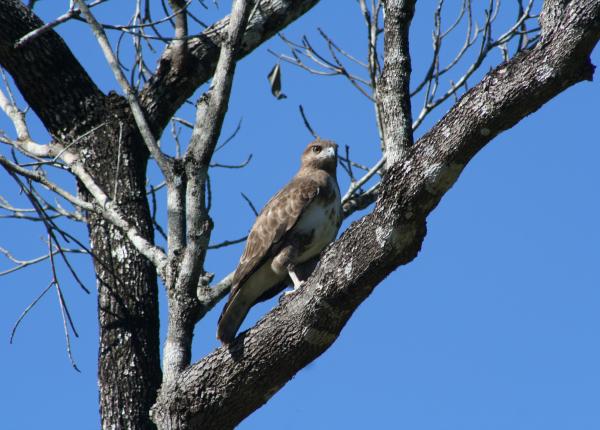Did You Know?
- The Madagascar Buzzard population appears to be stable and might even be increasing
- This hawk is one of the most common and wide-spread raptors in Madagascar
- When the Madagascar Buzzard is around, larger primates, such as Verreaux's sifaka, emit alarm calls. This could mean that these buzzards prey on these lemurs, though this hasn't yet been documented.
How The Peregrine Fund is Helping
Though The Peregrine Fund doesn't work directly with the Madagascar Buzzard, we have a very strong conservation program in Madagascar. Apart from the studies we conduct on several endemic raptors, we work hand in hand with the locals to help foster conservation on the island. Among our three conservation areas, we have assisted communities in planting more than 215,000 saplings to restore forests and establish plantations for food and jobs. We have fostered a professional staff of more than 30 Malagasy people, many with advanced degrees, who contribute scientific knowledge and lead their communities in conservation.
Additionally, our efforts in scientific research, habitat conservation, education, and community development help conserve birds of prey around the world. We also supply literature to researchers from our avian research library, which helps scientists around the world gather and share important information on raptor conservation.
Where They Live
The Madagascar Buzzard is endemic to Madagascar, an island in the Indian Ocean off the coast of the African continent. It is found throughout most of the country wherever good habitat can be found. What constitutes good habitat for a Madagascar Buzzard? Well, this hawk isn't too picky. It makes its home in a variety of areas including forests, open woodland, and secondary habitats with scattered trees.
It appears to be very adaptable to changes in its environment and has learned to inhabit some human-altered or degraded habitats. However, it is absent from the central plateau of Madagascar, which is heavily deforested.
What They Do
The Madagascar Buzzard is a medium-sized buteo. Though there is some variation in color among individual buzzards, in general they are brown overall with a distinctive white patch on its belly. It has a blue-tinted cere and pale legs.
This hawk spends a lot of time perching in a large or dead tree, which is a great place to look for them if you are ever in Madagascar. When searching for this bird, you can also keep your ears open for their calls, which have been described as "loud... squeals."
Why They Need our Help
The Madagascar Buzzard is classified as a species of Least Concern by the IUCN. This is due to the fact that this bird is still relatively common throughout Madagascar. However, this doesn't mean that this hawk doesn't face any threats. Biologists from The Peregrine Fund observed that this hawk is occasionally hunted for food by local villagers.
What They Eat
Like many predators, the Madagascar Buzzard is an opportunistic hunter. This means that it will hunt whatever it can get its talons on, and take advantage of any situation that might make catching an animal more easy. For example, one researcher observed an adult buzzard snatching a dove out of a mist net and consuming its head! The list of food items on this hawk's menu is quite long and includes rodents, small lemurs, small and medium-sized birds (including a young egret), snakes, lizards, chameleons, amphibians, terrestrial crabs, locusts, and centipedes.
When researchers observed this hawk hunting, they noticed it often made swift dives into the upper canopy, after gliding over the forest, or darting into the foliage from an emergent tree where it had been sitting.
Nests, Eggs, and Young
The Madagascar Buzzard builds a stick nest, which it constructs in the upper fork of a large forest tree, a palm, or even on a cliff ledge. Like many other birds of prey, these buzzards will line their nest with green leaves.
The female will usually lay 2 eggs, but most often only one young will survive. This could because the older, strong nestling kills its young sibling. This is known as siblicide. After the eggs are laid, the will need to be incubated for up to 37 days. After the nestling hatches, it will fly for the first time anywhere between 39–51 days later.
Madagascar Buzzard and the World Center for Birds of Prey
Though the World Center for Birds of Prey is far away from the Madagascar Buzzard's range, the center still offers fun ways to learn about this raptor and other birds of prey. Interactive activities, tours, interesting videos and a children's room with activities from coloring sheets to quizzes to costumes await you. At our visitor center, you can see many hawks up close and learn about the wonderful and interesting adaptations they have in order to survive in their respective habitats.
References:
Berkelman, J. 1995. Nest site characteristics of the Madagascar Buzzard in the rain forest ofr the Masoala Peninsula. Condor 97:273-275.
BirdLife International. 2016. Buteo brachypterus. The IUCN Red List of Threatened Species 2016: e.T22695957A93535514. https://dx.doi.org/10.2305/IUCN.UK.2016-3.RLTS.T22695957A93535514.en. Downloaded on 12 August 2021.
Global Raptor Information Network. 2021. Species account: Madagascar Buzzard Buteo brachypterus. Downloaded from http://www.globalraptors.org on 12 Aug. 2021
Kemp, A. C., P. F. D. Boesman, and J. S. Marks (2020). Madagascar Buzzard (Buteo brachypterus), version 1.0. In Birds of the World (J. del Hoyo, A. Elliott, J. Sargatal, D. A. Christie, and E. de Juana, Editors). Cornell Lab of Ornithology, Ithaca, NY, USA. https://doi.org/10.2173/bow.madbuz1.01
Raveloson, L., de Roland, L.A.R., Rakotondratsima, M., Benjara, A. and Thorstrom, R., 2021. Breeding biology and diet of the Madagascar Buzzard Buteo brachypterus in the Bemanevika Protected Area, Madagascar. International Journal of Biodiversity and Conservation, 13(2), pp.64-76.









